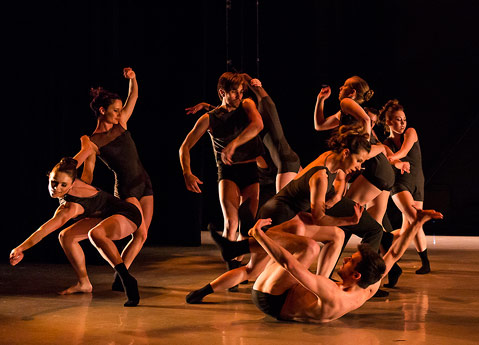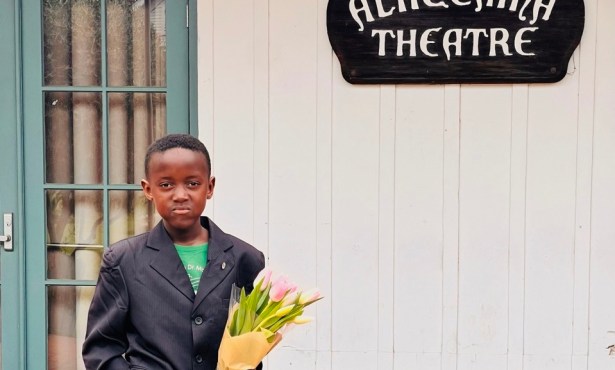State Street Ballet Presents ‘Women’s Work’
Impressive Dances by Five Choreographers

Taking a bold new step for both the company and for the dance community, State Street Ballet staged a mini-festival of five premieres on Saturday and Sunday, May 14 and 15 at the New Vic Theater. In an eloquent curtain speech, Sara Miller McCune spoke movingly of her friendship with the late Leni Fe Bland, the dedicatee of Women’s Work, which featured dances by five women – Cecily Stewart, Sophie Monat, Brook Hughes Melton, Kassandra Taylor Newberry, and Andrea Schermoly. McCune’s history lesson put Fe Bland on a continuum of women acting as patrons of the arts that extended all the way back to Queen Elizabeth I, and she emphasized the extent of Fe Bland’s involvement not only in the founding and development of State Street Ballet, but also in the rebuilding of the New Vic and the Granada. State Street Ballet has already done a magnificent job of making the Granada’s big stage its Santa Barbara home, and it was a pleasure to see that Rodney Gustafson and his troupe have now also found such a great way to make use of the New Vic as well.
From just reading the program, Sophie Monat’s “Vista” looked to be the most traditional of the bunch, and in some ways it was. Bach’s Violin Concerto in A Minor packs plenty of that cosmic sense of order that Bach produces and that dancers seem to exist to embody. However, this dance, featuring six women and three men, had all kinds of slides and curves and slurves that tilted the whole thing delightfully off center. It was followed by “Moult,” a brooding, sexually ambiguous trio by Brooke Hughes Melton. What fun it was to see Meredith Harrill in men’s clothing (costumed by Nicole Thompson) competing with Thomas Fant for the attention of Leila Drake. Filled with floor work and edgy exchanges of weight, “Moult” was, as Rodney Gustafson had warned us, “not your grandmother’s ballet.”
dgy exchanges of weight, “Moult” was, as Rodney Gustafson had warned us, “not your grandmother’s ballet.”
Kassandra Taylor Newberry contributed the evening’s most completely modern work, “(con)version,” which featured Thomas Fant and Meredith Harrill a nine-dancer ensemble. The soundtrack music, which was attributed to Thomas Newman and someone known only as “The Junkman,” mixed kooky percussion phrases with rhythmic sound effects such as an old-fashioned typewriter. Although the sound effects implied a critique of our regulated and mechanistic modern world, watching the dancers whip through Newberry’s complex figures offered the opposite message. If this is the modern world, one felt, these are the people who will thrive there. Socks were worn, removed, and at one point, left rather promiscuously on the stage.
After intermission, Lilit Hogtanian and Jack Stewart danced a duet by Andrea Schermoly. Set to the eccentric tones of Nina Simone’s “The Desperate Ones,” Schermoly’s piece of the same name conjured a new image out of the old “La Boheme” stereotype of the starving artist. These artists may have enough food, but, Schermoly (and Simone) seemed to ask, who has ever had enough hope?
One good answer to that came with the evening’s final and featured piece, Cecily Stewart’s ballet theater composition “Anne’s Window.” Anne Frank certainly had enough hope, and her example has lit up the lives of countless people in dozens of languages and thousands of places all over the world. Using eight dancers and an actor, Sofia Ross, who spoke the words of Anne Frank from a small desk at the corner of the stage, and then from amid the action, Stewart conjured the entire range of feelings contained in Frank’s extraordinary small universe. There was the agony of those who were arrested and taken away to the camps, but there was also the heartbreaking beauty of young love and a first kiss. The dancers sat at a long table to represent the tense, anxiety-filled process of eating a meal in self-enforced captivity.
Finally, in a long sequence that illustrated Frank’s determination to hang onto her ideals, no matter what, the choreography represented her inner world as a place of peace, justice, and solidarity. It reminded me of the great dream ballet in the second act of West Side Story, “Somewhere (There’s a Place for Us),” which memorably insisted that even when the outside world is profoundly hostile, somewhere “we’ll find a new way of living, we’ll find a place for forgiving.” “Hold my hand and I’ll take you there, hold my hand and we’re halfway there” the characters sing, and in “Anne’s Window,” we see this gesture become real as each of the dancers takes the hand of another in turn until the last link turns out to be missing, and a light comes on over Frank’s little desk, now empty. It was a terrifically poignant moment, and a powerful reminder of the way that dance can help access the emotional truths at the heart of our most profound experiences.



